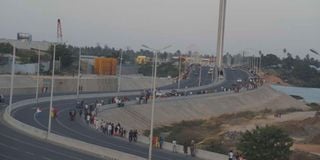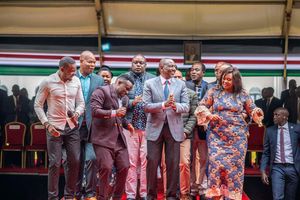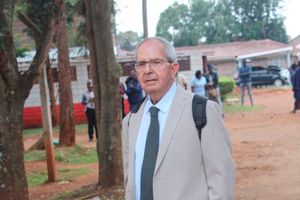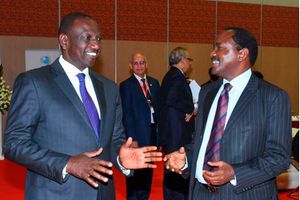‘Heaven’ road paved with cement, metal

In this file picture members of the public walk along Kigamboni Bridge in Dar es Salaam to celebrate Idd-ul-Fitr.
What you need to know:
- there is a new prince of Kenyan infrastructure: The 50-kilometre JKIA-Westlands highway (Nairobi Expressway).
- Its supporters seem not to run out of superlatives to describe it with some claiming Africa has not seen anything like it.
One of my good friends is from eastern Kenya. He is the unsentimental type who wouldn’t be caught dead buying flowers on Valentine’s Day. He is a big picture man, intellectually disciplined.
Last year, he was caught out. After the domestic Covid-19 restrictions were lifted, he went to see his parents for the first time in months. The tarmac road to his hometown is relatively new, and he had travelled on it twice since it was opened.
In the pandemic hibernation, the road was deserted. He came to a long stretch of it and, with the sun set about to set, and the virgin look from little use, and the bright line in the middle, it was a sight to behold. He stopped the car, took a photo and posted it on his social media page. It was much-liked.
Later, when I talked to him, he blamed the coronavirus. Death and peril, he said, had made him soft. He had looked at the “majesty of the road” and thought to himself, “these fellows [the Uhuru Kenyatta government] had actually done something; we need to give the devil his due”.
Well, maybe, but there is something else happening in Kenya, Africa and Asia. We are in the middle of a wave of infrastructure nationalism. In global terms, China is the grand master, the superpower. Be it roads, railways or bridges, it builds them like no one else in the world.
Nairobi Expressway
In the Kenyan Twitter wars, which have heightened as we gear towards the 2022 elections, whenever hashtags supporting President Kenyatta trend, it always comes down to metal, and concrete and mortar.
His supporters will post dramatic photos of the standard gauge railway (SGR) — and his critics lambast it as an atrociously expensive ‘white elephant’ — and new or surfaced roads, new markets and county headquarters in the devolved counties, new hospitals, the new floating pedestrian bridge at Likoni, Mombasa (East Africa’s first, we are reminded) and the ongoing pimping up of long-neglected Nairobi.
Now there is a new prince of Kenyan infrastructure: The 50-kilometre JKIA-Westlands highway (Nairobi Expressway). Its supporters seem not to run out of superlatives to describe it with some claiming Africa has not seen anything like it.
Even as it divides opinion, infrastructure has become Africa’s new nationalist springboard. You can be an incompetent, corrupt and even cruel government and almost away with it but you will be toast if you don’t lay down some cement and metal to give your people something to crow about, especially when they get in the inevitable Twitter war with other Africans.
Magic worker
There is in Kenya now a big revisionist movement that sees retired President Mwai Kibaki as having been a magic worker. And a lot of praise goes to his infrastructure-building binge. My long-held generally favourable view of Kibaki is poorly disguised but his infrastructure build would not be anywhere near the top of my list.
His policies were important for Kenya’s digital leap and what it ignited in East Africa. He resurrected a dead economy and made it tick. He oversaw a democratic recovery and the freest period in Kenyan media history. Though he was caught with his hand in the election cookie jar in 2007, in the end he shared power. Also, the expansion of the East African Community would have taken a different trajectory without him.
But those kinds of things don’t make for good tweets and political stage one-liners. People understand long stretches of road and garish big new market buildings where once smelly and rickety ones stood. Social indicators don’t tag at the patriotic heart.
Thus, a country like Rwanda gets plaudits for having the cleanest capital, and streets, yet its more civilisationally important achievement is the quickest and biggest drop in infant mortality. However, you can’t photograph that, so sorry.
Cement and metal
Kenya, though, still needs to learn from its partners in the EAC when it comes to this worship of cement and metal. There’s the Kigamboni Bridge in Tanzania’s commercial capital Dar es Salaam. It was East Africa’s first long cable-stayed bridge. Then Uganda came along with the Source of the Nile Bridge. And Rwanda has Kigali Convention Centre (KCC). These have lights, so at the Nile Bridge and KCC, they light them with the national flag on Independence Day. And friendly nations, Earth Day and so forth will also get their colours — and social media posts.
The SGR, and Nairobi Expressway, don’t have a light platform or dome. Patriotic cement needs some colour and icing on the top to go down.
It also leaves the high-minded, who think improved school outcomes are more important than the length of tarmac roads (and they are right) conflicted, because roads are important. In our neck of the woods not everyone will forget if your government was corrupt, and you stole votes.
But if you lay down a lot of cement, rail track and hanging bridges and have lots of bright lights up, you will find a lot of forgiveness after you leave.
Mr Onyango-Obbo is a journalist, writer and curator of the Wall of Great Africans. @cobbo3





